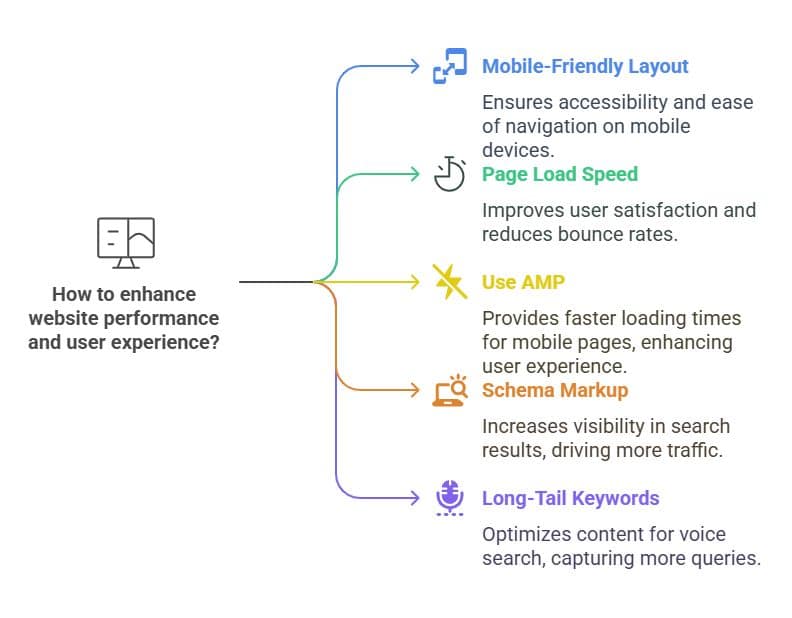
Enhancing SEO for your mobile site involves a strategic combination of design, speed, and optimization techniques. A mobile-friendly design is crucial for creating a positive user experience, while fast loading speeds help maintain high engagement levels and reduce bounce rates. Using responsive layouts ensures that your site adapts seamlessly across various devices. Optimizing images with formats like WebP and employing techniques such as lazy loading can significantly improve load times. Implementing Accelerated Mobile Pages (AMP) is another effective way to boost speed, and utilizing structured data helps increase your visibility in search results. Local SEO strategies are essential for ensuring your listings are accurate and engaging, which can attract nearby users. Additionally, crafting effective meta tags and optimizing for voice search can help draw in and engage more visitors. By delving deeper into these strategies, you will discover how to optimize mobile sites for SEO and maximize your site’s performance and reach.
Key Takeaways
- Put in place a mobile-friendly layout with touch targets that are easily accessible and easy to navigate.
- Increase the speed at which pages load by using caching, responsive design, and image optimization.
- For improved user experience and quicker loading times, use AMP (Accelerated Mobile Pages).
- Use schema markup and structured data to increase your visibility in search results.
- Use long-tail keywords and conversational questions to modify material for voice search.

Mobile-Friendly Design
A mobile-friendly design is crucial for enhancing the user experience on mobile devices and improving SEO performance. As mobile usage continues to surpass desktop browsing, companies must ensure their websites prioritize efficient touchscreen navigation. This involves crafting an intuitive interface where users can effortlessly interact with site elements, which enhances the mobile user experience and keeps users engaged longer.
One of the fundamental aspects of a mobile-friendly design is the consideration of font size. Text that is too small can frustrate users and lead to higher bounce rates, negatively impacting SEO. Ensuring that the font size is readable without zooming or excessive scrolling not only improves readability but also aligns with Google’s mobile-first indexing practices, which favor sites that are easy to navigate on smaller screens.
Equally important is button accessibility, which refers to the ease with which users can tap on buttons and links. Buttons should be large enough to be easily tapped without accidentally hitting adjacent elements, enhancing user satisfaction.
This is where a thumb friendly design becomes paramount; since most users hold their devices with one hand, designs should accommodate natural thumb movements. Placing important navigational elements within the “thumb zone” can significantly improve the mobile user experience.
Page Load Speed

When browsing on mobile devices, users expect swift access to content, making page load speed a critical factor in mobile SEO optimization. As the demand for instantaneous information grows, ensuring that a mobile site loads quickly is essential not only for user satisfaction but also for maintaining or improving search engine rankings.
A significant aspect of enhancing page load speed involves employing mobile caching techniques. By storing static assets like images and scripts locally on a user’s device, mobile caching reduces the need to reload these resources during subsequent visits, thus expediting loading times.
User experience optimization is another crucial element closely tied to page load speed. A fast-loading mobile site can significantly improve user engagement and retention, reducing bounce rates and encouraging longer session durations.
Furthermore, integrating mobile link building strategies can enhance page authority without compromising speed. By ensuring that links are relevant and load efficiently, a mobile site can gain credibility while maintaining quick access to content.
Monitoring page load speed through mobile analytics tracking provides insight into performance issues and areas for improvement. By analyzing loading times and related metrics, site owners can identify bottlenecks and optimize their sites accordingly.
Additionally, implementing touch friendly navigation aids in reducing load times by ensuring that navigational elements are efficiently coded and responsive to touch inputs.
Responsive Layout

Responsive layout’s importance in mobile SEO cannot be overstated, as it ensures that a website’s design adapts seamlessly to various screen sizes and orientations. With the increasing prominence of mobile devices, websites must provide a consistent and engaging user experience. This adaptability is crucial in the era of mobile first indexing, where search engines prioritize the mobile version of a site for ranking and indexing purposes.
A key element of responsive design is the use of adaptive images, which automatically resize and adjust to fit different screen dimensions without compromising quality. This optimization not only enhances the visual experience but also contributes to faster loading times, an essential factor for both user satisfaction and SEO performance.
Alongside images, touch targets—such as buttons and links—must be designed with adequate spacing and size, ensuring they are easily accessible on smaller screens without risking accidental clicks.
Viewport settings also play a pivotal role in responsive layout. By establishing the correct viewport, developers ensure that a website scales appropriately across different devices, maintaining consistent proportions and usability. This is essential for preserving the integrity of the website’s design and functionality, regardless of the device being used.
Additionally, font legibility is a critical consideration in responsive design. Text must be easily readable on small screens without requiring users to zoom in or strain their eyes. Proper font sizing and spacing ensure that content remains accessible and engaging, directly impacting user experience and retention.
Image Optimization

Building upon the foundation of a responsive layout, optimizing images for mobile sites is a vital aspect of enhancing both user experience and search engine performance. Images significantly impact a site’s load time and visual appeal, making their optimization crucial for mobile SEO. Implementing strategies like choosing the right image formats, applying image compression, and using lazy loading can greatly improve site efficiency.
Image Optimization Techniques

| Technique | Description | Benefit |
| Image Formats | Utilize formats like WebP for smaller file sizes. | Faster loading times |
| Lazy Loading | Load images only as they appear on the screen. | Reduced initial page load |
| Alt Text | Use descriptive text for images. | Improved accessibility and SEO |
| Image Compression | Minimize file sizes without losing quality. | Enhanced performance and quick loading |
| Visual Hierarchy | Prioritize important images in the layout. | Better user experience and engagement |
Choosing the appropriate image formats, such as WebP, can result in significantly smaller file sizes without compromising quality, leading to improved loading speeds. Image compression further reduces file size, ensuring the mobile site remains swift and responsive.
Lazy loading is an effective technique where images are loaded only as they become visible on the screen, reducing the initial load time and conserving bandwidth, which is particularly beneficial for users on limited data plans. It’s also essential to incorporate alt text for images, providing descriptions that enhance accessibility and contribute positively to SEO rankings.
Additionally, maintaining a clear visual hierarchy ensures that essential images are prioritized, guiding users’ attention effectively and improving engagement. By integrating these image optimization strategies, a mobile site can achieve a harmonious balance between aesthetic appeal and technical performance, ultimately boosting its search engine visibility and user satisfaction.
Use of AMP

How can mobile sites enhance their loading speed and user experience to meet the demands of an increasingly mobile-first world? One effective method is through the use of Accelerated Mobile Pages (AMP). AMP implementation offers a streamlined way to create mobile-optimized content that loads almost instantaneously. By utilizing AMP, businesses can significantly improve their site’s performance, leading to enhanced user satisfaction and potentially higher search engine rankings.
The AMP benefits extend beyond just speed. Unlike traditional web pages, AMP strips down HTML to include only essential components, reducing server load and improving efficiency. This lightweight framework enables faster load times, which can decrease bounce rates and increase user engagement.
AMP analytics tools further allow webmasters to track user interactions and measure the impact of AMP on site performance, providing valuable insights for ongoing optimization.
When comparing AMP vs. traditional web pages, AMP not only offers a superior speed advantage but also simpler maintenance. With fewer elements to manage, AMP content strategies can be more focused, allowing developers to prioritize user experience without the complexity of managing a full-scale site.
However, it is crucial to ensure that critical content is not stripped away during AMP implementation, as this could negatively impact user engagement.
Incorporating AMP into a mobile SEO strategy can be a game-changer, offering a competitive edge in an environment where speed and user satisfaction are paramount. By leveraging AMP, sites can deliver faster, more engaging experiences that meet the ever-growing expectations of mobile users.
Structured Data

To enhance the visibility and relevance of mobile sites in search engine results, implementing structured data is crucial. Structured data, particularly schema markup, plays a vital role in how search engines interpret the content of a mobile site. By organizing data in a way that search engines can easily understand, sites can improve their chances of appearing prominently in search results. This is especially important with mobile indexing, where the mobile version of a site is prioritized for ranking.
Schema markup allows webmasters to define elements within their content hierarchy, making it easier for search engines to display relevant information as rich snippets. Rich snippets can include star ratings, event details, or recipe instructions directly in search results, which can enhance click-through rates. These enhancements are not only beneficial for user engagement but also for improving overall SEO performance.
Implementing structured data requires careful data testing to ensure that schema markup is correctly applied and reflects the intended content. Google’s Structured Data Testing Tool is an invaluable resource in this process, allowing developers to validate their code and rectify any errors that could hinder search engine understanding.
This meticulous approach not only supports mobile indexing but also ensures that the information presented is accurate and beneficial to users.
Incorporating structured data effectively aligns content with search engine algorithms, providing a competitive edge in the mobile SEO landscape. By adopting schema markup and conducting thorough data testing, businesses can significantly enhance their mobile site’s search visibility, ultimately driving more targeted traffic to their digital platforms.
Local SEO Strategies

Navigating the intricacies of local SEO is essential for businesses aiming to capture attention within their geographical area. As mobile device usage continues to rise, optimizing your mobile site for local search becomes even more crucial. An effective local SEO strategy ensures that potential customers can easily find your business when searching for relevant services nearby.
Key components of an impactful local SEO strategy include maintaining accurate local listings and encouraging positive customer reviews. Accurate local listings across various platforms help search engines verify your business’s credibility and improve visibility. Additionally, customer reviews not only enhance your reputation but also influence search rankings. Engaging with customers to solicit and respond to reviews can significantly boost your local SEO performance.
Effective citation building is another vital part of strengthening local SEO. Consistent citations of your business name, address, and phone number (NAP) across different websites and mobile directories reinforce your business’s legitimacy in the eyes of search engines. Ensuring uniformity in these citations helps avoid confusion and builds trust with search engines and potential customers alike.
Here are some actionable steps to bolster your local SEO strategy:
- Optimize local listings: Ensure your business information is accurate and consistent across platforms such as Google My Business and Yelp.
- Engage with customer reviews: Actively solicit and respond to reviews to build a positive online reputation and improve search rankings.
- Invest in citation building: Ensure your business’s NAP information is consistent across mobile directories and other relevant websites.
Incorporating geo-targeted ads can further enhance your visibility by reaching customers within a specific area, driving local traffic to your mobile site. By prioritizing these strategies, businesses can effectively improve their mobile local SEO and capture the attention of nearby potential customers.
Mobile Usability

As businesses continue to invest in local SEO strategies, ensuring a seamless mobile experience becomes increasingly important. Mobile usability is a critical factor in achieving a strong SEO performance, as it directly impacts user satisfaction and engagement.
Effective mobile navigation is essential; it allows users to easily explore a website without unnecessary friction, enhancing their overall experience. A well-structured navigation menu should be intuitive and accessible, enabling users to locate information swiftly and effortlessly.
Touch targets are another crucial aspect of mobile usability. These are the interactive elements such as buttons and links that users tap on mobile devices. Ensuring these targets are adequately sized and spaced prevents accidental clicks, reducing user frustration and improving overall site interaction.
In addition, integrating accessibility features into mobile design ensures that content is reachable for all users, including those with disabilities, thereby broadening the audience and improving user experience.
Content hierarchy plays a significant role in mobile usability. By prioritizing the most important information and structuring it logically, users can quickly access the content they need.
This approach not only enhances user engagement but also influences search engine rankings positively, as algorithms tend to favor well-organized content.
Voice Search Optimization
The advent of voice search technology has transformed the landscape of digital interaction, prompting businesses to adapt their SEO strategies to cater to this growing trend. As voice assistants like Siri, Alexa, and Google Assistant become ubiquitous, understanding voice search trends is crucial for optimizing mobile sites.
The shift from traditional text-based searches to voice-driven interactions requires SEO professionals to rethink how content is structured, focusing on conversational queries and natural language.
Voice search optimization involves anticipating the search intent of users who prefer speaking over typing. This requires crafting content that aligns with the way people naturally speak and form questions. For instance, instead of targeting the keyword “best Italian restaurant,” a business might optimize for a query like “What’s the best Italian restaurant near me?” Such conversational queries demand a nuanced understanding of user behavior and search intent.
To effectively optimize for voice search, consider the following strategies:
- Prioritize Question-Based Content: Users frequently ask questions when using voice search. Structure content to answer these queries succinctly.
- Enhance Local SEO: Many voice searches are local in nature. Ensure that your business information is accurate and consistent across all local directories.
- Focus on Long-Tail Keywords: Voice searches typically contain more words than text searches. Targeting long-tail keywords can help capture this traffic.
Effective Meta Tags

While voice search optimization addresses the nuances of conversational queries, another key aspect of enhancing mobile SEO is the implementation of effective meta tags. Meta tags play a pivotal role in how search engines perceive and rank your mobile site. By adhering to meta tag best practices, you can ensure that your content is both accessible and attractive to search engines and users alike.
Title tag optimization is a fundamental component of meta tag enhancement. A well-crafted title tag succinctly conveys the page’s primary theme while incorporating relevant keywords. This not only aids search engines in understanding the content but also compels users to click through, improving your site’s click-through rate (CTR).
Keyword targeting strategies should be employed judiciously within title tags, as these are critical in capturing the essence of the content and aligning with user search intent.
The meta description, although not a direct ranking factor, has a significant meta description impact on user engagement. An engaging meta description serves as a mini-advertisement for your page, encouraging users to visit your site. Crafting descriptions that are informative, concise, and include a call-to-action can enhance mobile user experience and drive traffic.
Social media integration should not be overlooked in the context of meta tags. Open Graph and Twitter Card tags ensure your content is displayed optimally when shared on social platforms, thereby extending your reach beyond search engines.
Final Thoughts
Enhancing SEO for your mobile site is an essential strategy in today’s digital landscape. By focusing on mobile-friendly design, improving page load speed, and utilizing responsive layouts, you can significantly enhance user experience and engagement. Effective image optimization, implementation of AMP, and structured data are crucial for boosting visibility and performance in search results. Local SEO strategies further ensure that your business reaches nearby customers effectively. As mobile usability and voice search continue to gain importance, adapting your content to meet these demands is vital. By applying these techniques, businesses can create a robust mobile presence that not only attracts more visitors but also improves search engine rankings.
Looking to boost your mobile site’s SEO performance and achieve lasting digital success? Connect with Syville Gacutan, an experienced SEO Specialist in the Philippines. With a proven track record in mobile optimization, technical SEO, and search visibility enhancement, Syville can help your business reach new heights online. Contact Syville today and start transforming your mobile presence.